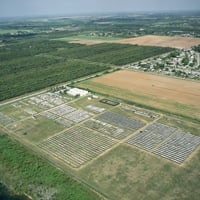 This is a simple question, but unfortunately there is no simple answer. It is theoretically impossible to have a single "magic number" that you can multiply by weathering tester exposure hours to compute years of outdoor exposure. The problem is not that we just haven't developed the perfect weathering tester yet. No matter how sophisticated or expensive you make your weathering tester, you still won't find the magic factor. The biggest problem is the inherent variability and complexity of outdoor exposure situations.
This is a simple question, but unfortunately there is no simple answer. It is theoretically impossible to have a single "magic number" that you can multiply by weathering tester exposure hours to compute years of outdoor exposure. The problem is not that we just haven't developed the perfect weathering tester yet. No matter how sophisticated or expensive you make your weathering tester, you still won't find the magic factor. The biggest problem is the inherent variability and complexity of outdoor exposure situations.
The relationship between tester exposure and outdoor exposure depends on a number of variables, including:
- The geographical latitude of the exposure site (closer to the equator means more UV).
- Altitude (higher means more UV).
- Local geographical features, such as wind to dry the test samples, or the proximity of a body of water to promote dew formation.
- Random year-to-year variations in the weather, which can cause degradation to vary as much as 2:1 in successive years at the same location.
- Seasonal variations (i.e., winter exposure may be only 1/7th as severe as summer exposure).
- Orientation of the sample (5° South, vs. vertical North).
- Sample insulation (outdoor samples with insulated backing often degrade 50% faster than uninsulated samples).
- Operating cycle of the tester (hours of light and hours of wetness).
- Operating temperatures of the tester (hotter is faster).
- The particular material tested.
- The Spectral Power Distribution (SPD) of the laboratory light source.
Obviously, it is logically meaningless to talk about a conversion factor between hours of accelerated weathering and months of outdoor exposure. One is a constant condition, whereas the other is variable. Looking for a conversion factor requires pushing the data beyond the limits of its validity.
In other words: Weathering data is comparative data. Nevertheless, you still can get excellent durability data from accelerated weathering testers. But you must realize that the data you get is comparative data, not absolute data. The most you can ask from laboratory weathering are reliable indications of the relative ranking of a material's durability compared to other materials. In fact, the same thing can be said about Florida exposure tests. Nobody knows how a year in an outdoor "Black Box" exposure at 5° South compares to a year on a house or a car. Even outdoor testing gives you only relative indications of actual service life.
Comparative data, however, can be very powerful. For instance, you might find that a slightly altered formulation has over twice the durability of your standard material. Or you might find that among several suppliers offering what look like identical materials, some fail very quickly, most fail in a medium length of time, and a few fail only after prolonged exposure. Or you might find that a less expensive formulation has equivalent durability to your standard material that has given acceptable performance over, say 5 years, of actual service.
Here is a good example of the power of comparative data. A coatings manufacturer was developing a new type of clear coating. Initial QUV tests caused severe cracking in 200 to 400 hours. This is much sooner than conventional coatings used for the same purpose. However, after 3 years of continual reformulation and retesting in the QUV tester, the coating was improved so that various formulations could withstand 2,000 to 4,000 hours in the QUV tester - much better than the conventional coatings. Subsequent parallel tests in Florida showed a similar 10:1 increase in durability. Yet if the coatings chemists had waited for the Florida data before changing their formulations, they would still be back in the early stages of reformulation, and the coating wouldn't be the commercial success that it now is.
On the other hand, if you still insist on an approximate conversion factor, find it empirically. Despite the impossibility of a universal conversion factor, hundreds of labs have successfully developed their own internal approximations for converting their Q-SUN or QUV tester hours into outdoor exposure hours. However, it is important to remember that these values were developed from empirical comparisons of the lab's own accelerated tests with their own outdoor exposures. Furthermore, these conversions are valid only for:
- The specific material tested.
- The specific set of lab tester time cycles and temperature.
- The specific outdoor exposure site and sample mounting procedure.
If you have outdoor experience with your materials, it shouldn't take more than a few months to develop your own approximate acceleration factor. If you don't have experience with your own materials, it may be possible to work with competitive materials that do have a history of outdoor service. Many labs have successfully developed their own factors for converting Q-SUN or QUV tester hours into exposure hours.
In addition, it is important to remember: Correlation means Rank Correlation. When someone asks, "How do the accelerated testers correlate with outdoors?" what they really should ask is, "How well do rankings of materials' durability in the accelerated testers duplicate the rankings of materials outdoors?"
To measure rank correlation, we recommend Spearman's rho, a statistical measure that is easy to compute and which does not require the type of strong assumptions about the data that are required by linear correlation measures. A study of QUV tester and Florida durability rankings of 27 automotive coatings produced rank correlations of up to .089 between QUV tester rankings and Florida rankings. The rank correlation between different Florida exposures was 0.88 to 0.95. In other words, the QUV tester can reproduce Florida rankings for these coatings almost as well as Florida can reproduce itself!
See Technical Bulletin LU-0833 for more information.
Visit the Q-Lab Weathering & Corrosion Blog for more posts like this.

